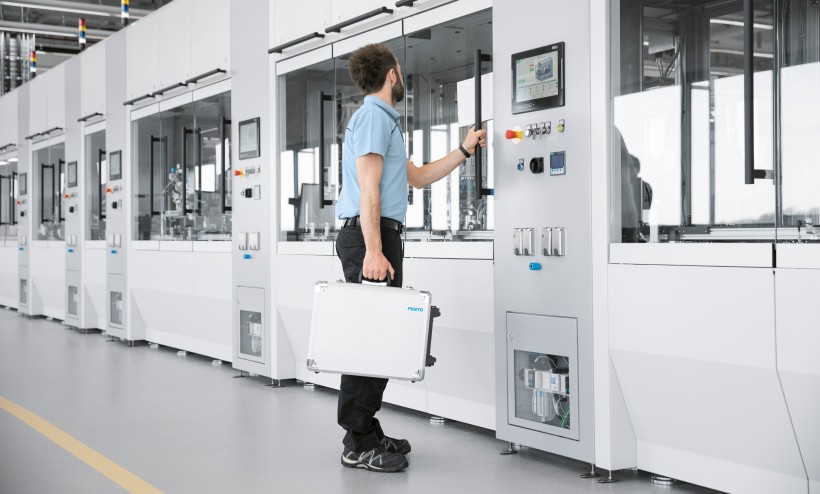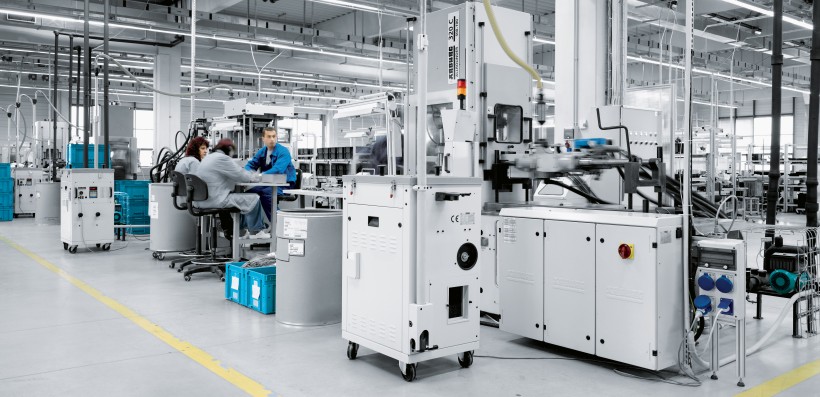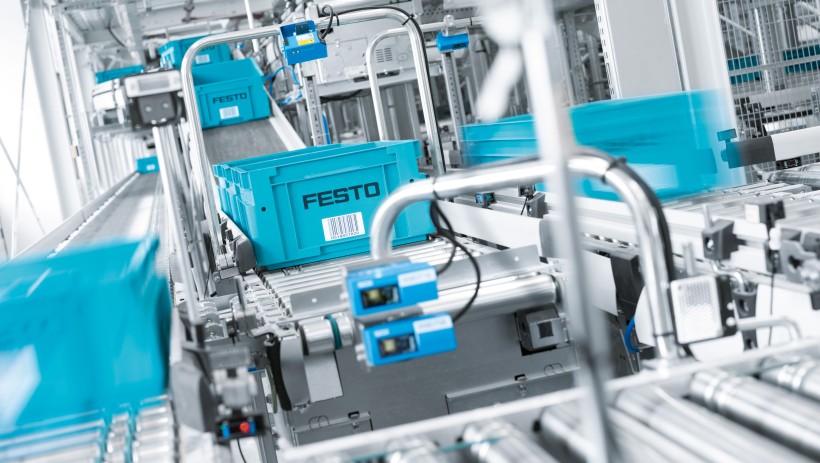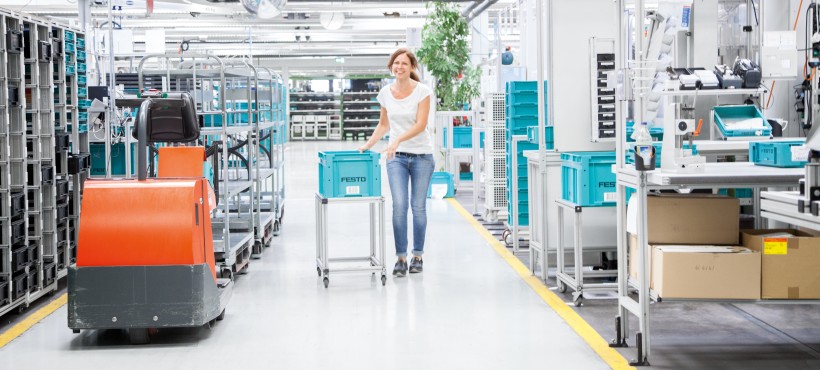Industry 4.0 in practice
Flexible, simple, reliable and extremely productive, Industry 4.0 brings together Festo’s various areas of expertise and offers a wide variety of advantages for your production. We will provide you with an overview of the areas where you can prepare for Industry 4.0 and show you solutions, practical examples and suitable products.
Industry 4.0 in production
Highly flexible assembly lines

In times of volatile markets and customised products down to a batch size of 1, rapid batch changes have become a crucial factor. Modular manufacturing intelligence directly at field level provides the necessary flexibility, such as in the design of valve terminals or carrier systems with built-in controllers.
In the SmartFactory Industry 4.0 research project, Festo played a major role in making flexible, modular and interconnected machine cells from various manufacturers a reality. Festo has already put this into practice at its Scharnhausen Technology Plant. There, the company is showing, among other things, that the set-up times of networked assembly lines can be reduced from several hours to just 13 seconds. This means that you can also easily implement new technologies or production methods in a single afternoon. Even the time needed to relocate the entire system can now be reduced from three weeks to just three days.
It’s important to note that in Industry 4.0, existing systems can also be kept cost-effective with suitable retrofitted components. For the time being, manufacturers or users will have to define the specifications of the machine interfaces for their own processes themselves; the relevant standards or VDMA recommendations have yet to be released.
Systems designed for industrial energy efficiency

Energy costs are not going to decrease by themselves. The key to efficient production lies in your own resources and in energy management that is only possible in connected systems. The Festo production building, the Scharnhausen Technology Plant, is a prime example. With features such as excellent insulation, heat recovery and compressed air generation tailored to demand, the site meets the highest energy standards.
Above all, however, connected sensors monitor the consumption of every machine. The M2M (machine to machine) applications communicate autonomously via OPC UA with the manufacturing execution system (MES), which is configured for optimal synchronisation and prevents energy peaks. Existing systems were retrofitted with the necessary sensors and mini control systems, including the electrical terminal CPX and our energy efficiency module MSE6-E2M. This required an investment of approximately 3,000 to 5,000 euros per machine. In terms of benefits, this will save the factory about 3 GWh of energy and the investment will pay for itself in less than three years. In other customer projects, the support provided by our Festo Energy Saving Services has even resulted in savings of up to 60%. For new systems, the greatest potential lies in their cost-effective design.
Mobile, connected maintenance

A major benefit of Industry 4.0 is predictive maintenance, which minimises unplanned downtime. iPads were an essential part of the pilot project at Festo as they enable service personnel to not only view system error messages on their tablets, but also all repair instructions, plans, bills of materials and spare parts lists. If necessary, they can consult experts via chat, load past repair orders and take a look at the spare parts warehouse online. This makes it immediately clear which error messages are still unresolved and which employee and priority they have been assigned.
In the future, maintenance activities could be expanded even further to include a real-time connection to the order list and AR (augmented reality) support. The pilot project was so successful that we are currently rolling out this system in all Festo factories. The production systems’ OEE (overall equipment effectiveness) has increased significantly, employees are more motivated and the investment has paid for itself in less than six months.
You can also use the AX Smartenance (smart maintenance) mobile maintenance app in your factory as a digital maintenance manager.
The Festo Scharnhausen Technology Plant

Industry 4.0 is all about practical applications. In our Scharnhausen Technology Plant we produce our valves, valve terminals, printed circuit boards and modules on networked assembly lines in a flexible, energy-efficient and highly productive process.
Digital process optimisation
Demand-driven ordering without bottlenecks

According to E. M. Goldratt’s Theory of Constraints (TOC), every value creation process is subject to a constraint. Upstream of the constraint, everything jams up, whilst downstream production often runs empty. The goal is to locate and eliminate this bottleneck, so that the next bottleneck becomes visible and can also be resolved.
We have expanded this continual TOC approach at the Scharnhausen Technology Plant and developed it into a bottleneck-oriented organisation. The focus is specifically on lead times and delivery performance. The relevant KPIs are throughput, inventory and operating costs. In practice, this means all machines are systematically connected to an Industry 4.0 network so that everyone involved receives the necessary data from the online MES on their screen, whether they are using a desktop PC, tablet or smartphone.
This works extremely well, both for us and for our project partners. In the metalworking industry, for example, demand-based ordering from a bottleneck-oriented organisation has cut throughput times by 56% across the plant and by as much as 90% in individual performance units.
Flow production without extensive buffer stock

Compared to batch production, flow production is much more flexible. Throughput times are short, quality is excellent and space requirements are also low. One-piece flow processes in particular can be designed so that buffer stocks can be largely eliminated and production can be managed with much greater flexibility.
A practical example is our implementation of Heijunka systems as part of the bottleneck-oriented organisation, involving a complete process chain from sawing to deburring, drilling and milling, to fine machining and surface treatment. Technically speaking, this also includes using intelligent handling solutions from Festo and M2M (machine to machine) communication via OPC UA. This keeps the machines’ operating data and KPIs synchronised at all times. In the event of a malfunction, the entire line can be adjusted accordingly, so that it doesn't simply push along the material flows that then need to be processed on weekends or during expensive night shifts.
Product Key for error-free orders

In the digital twin scenarios of Industry 4.0, unique, machine-readable identification is absolutely essential. This is already being implemented at Festo: the Product Key is either a QR or data matrix code or an eleven-digit alphanumeric code that clearly identifies each product. This means you always have reliable access to data such as the type code, serial number and version. This may sound familiar, but the Product Key can do even more. For example, it can automatically open the correct user documentation and CAD data. And it greatly simplifies the process of ordering components and spare parts. The integrated ident code allows maintenance personnel or engineers to put through orders while working, correctly, efficiently and absolutely error-free, even in the case of complex valve terminals and subsystems with hundreds of individual parts.
The Product Key from Festo is even cloud-ready, since it can be used as an access code for systems that you configure (or reconfigure) using an app and manage via IIoT platforms. As a result, you can easily obtain the latest firmware, upgrades and services from the Festo App World and always stay on the safe side.
Mobile maintenance based on efficiency criteria

Ticket systems are certainly very helpful, but intelligent solutions that are designed for flow production processes and bottleneck-oriented organisation are even better.
Firstly, this means that maintenance staff are truly mobile and have all the necessary application and machine data available online in real time on their tablets while out in the field. An app directs them to the next location before it becomes a bottleneck. This eliminates the need to travel from the central maintenance office to work on the machine, saving several hours of work per week for larger companies. Secondly, the orders can then be prioritised according to efficiency criteria such as capacity utilisation, order status and the value of the machine’s output. Thirdly, mobile maintenance is really what empowers maintenance staff to take action; in an ideal situation, you can immediately and automatically order spare parts online using the Product Key.
Smart logistics with a digital twin

One example of an HMI (human-machine interface) that is based around people is the ProGlove, which looks like a normal work glove, only it has a bar code scanner built into the back of the hand. Employees in logistics activate it via built-in thumb sensors, allowing them to automatically create a digital record of what they are handling during loading and unloading. In addition, they also have both hands free. This is faster and also works flawlessly at assembly and manual workstations.
At our Scharnhausen Technology Plant, we have already widely implemented this smart industry approach and have marked and coded the assembly equipment so that employees automatically pick up the right parts, ensuring that work is simple, fast and error-free. We thus create a true ‘digital twin’ of our production processes at the same time. This, in turn, allows production volumes and material flows to be controlled in a flexible, demand-driven and efficient manner.
Products and solutions from Festo
Via CPX IoT gateway directly into the cloud

For machine and production data to be useful in a connected industry, it needs to be pooled, consolidated and easy to manage. This is the job of the CPX IoT gateway. Depending on the complexity, between 10 and 31 components and modules at shop-floor level can communicate in real time via a secure OPC UA interface. The gateway translates the data streams into AMQP (MQTT and others on request), ensuring they are both secure and cloud-ready. This opens up the full range of Industry 4.0 and modern data-analysis options, from smart maintenance to complete digital twins.
Our IoT gateway has already been equipped with preconfigured dashboards that can be customised on-screen and include widgets with traffic-light indicators and diagrams for preventive maintenance and workload control. It is ready to be used straightaway, for example, in cyber–physical systems such as the energy efficiency module MSE6-E2M, the handling system YXMx or our Motion Terminal VTEM.
In practice, this has two outcomes: turnkey condition monitoring with automatic alerts and reliable fault diagnostics in real time, as well as extensive options for business data analytics in the Festo Cloud, with trend analyses, early warning systems and control options to increase overall system effectiveness based on reliable performance data.
Data analysis from the Festo Cloud
Reliable KPIs are the basis of every expert support system, every well-founded company decision and every effective process optimisation. All the data from the IoT gateways is therefore collected and processed in the Festo Cloud for intelligent data analysis, whether clearly presented in the form of intuitive dashboards or complex long-term analyses.
In the future, the way that industrial companies manage their own data volumes will be a critical success factor. Extensive Industry 4.0 control and optimisation capabilities are already available at the cloud level. So far, the Festo Cloud is directly helping to reduce downtime, improve capacity utilisation and increase overall productivity. Moreover, production companies as well as machine and system builders are already working on new business and revenue models as a result of refining and processing cloud machine data.
Field intelligence in the Motion Terminal VTEM

Industry 4.0 is far more than just sensor technology that passes machine data to the cloud. Genuine cyber–physical systems also work the other way around, bringing control intelligence to the field level and even making pneumatics digital. Our Motion Terminal VTEM provides a simple way to add Industry 4.0 functions to existing systems. The individual valves are controlled by apps and are freely programmable via WebConfig, e.g. for pressure level, flow control, directional control valve function and leakage diagnostics. The Motion Terminal VTEM gives machine and system builders significantly more freedom and simplifies pneumatic circuit design. It performs functions that would have previously required more than 50 different products or positions. Above all, however, it means that compressed air is digitalised. With the Motion Terminal VTEM, you simply change a valve’s functions via software instead of modifying the hardware.
Parallel engine block assembly
Thanks to decentralised intelligence on the valve terminal CPX/VTSA, the grippers mount the seal, piston and cylinder head simultaneously instead one after the other – with the OPC UA interface instead of a control cabinet.
Engineering for the smart factory
Automation Markup Language (AML)

Automation Markup Language (AML) has established itself as a data exchange format designed specifically for diverse development environments and manufacturer-independent engineering. Although the XML-based language historically originated in the automotive industry, the developer consortium created it as a general ‘digital enabler’. Festo is itself a member of the AutomationML association’s management board and, together with other renowned specialists and research institutes, is involved in the development, standardisation and further distribution of the standard, especially for the implementation of smart tools in the AutomationML project (Engineering Tool Chain for Efficient and Iterative Development of Smart Factories).
AutomationML is not a proprietary format, but is instead designed to be neutral and extendable. In fact, AML makes work for engineers in machine building much easier than, for example, in home automation, where developers have to struggle with a large number of interface issues and a variety of different, incompatible systems. AML enables the exchange of system planning data and access to reliable documentation, but also covers, for example, the implementation of system simulations in live systems.
Administration shell for M2M collaboration

An open consortium led by the German Electrical and Electronic Manufacturers’ Association (ZVEI) has already presented a reference architectural model for Industry 4.0 (RAMI 4.0) as part of the Plattform Industrie 4.0 network with support from Germany’s Federal Ministry for Economic Affairs and Energy, and defined the essential characteristics of an Industry 4.0 component. The open-source cooperation project openAAS (open Asset Administration Shell) is now focusing on an open administration shell for such components. The protocol is based on OPC UA (unified architecture), which is already used in all the products from Festo that are Industry 4.0-compatible.
In practice, the objective is to describe an Industry 4.0 component as an encapsulated system with interfaces, and thereby create a digital copy – the basis of all digital twin concepts and the basis of every M2M (machine to machine) collaboration. Festo is playing a key role in this development and the first pilot implementations have already been successful.
BigDieMo: data-based business models

Big data is the focus of a collaborative research project funded by Germany’s Federal Ministry of Education and Research that will run until mid-2019. The objective is to develop methods that enable companies to build new business models based on the volumes of data generated in the context of Industry 4.0.
As part of BigDieMo, Festo is responsible for developing a modular system with methods and tools that can be used to create data-based services in a structured manner. In the process, we can draw on our own experience at the Scharnhausen Technology Plant as well as on the results from pilot systems at customers’ facilities. Maintenance has always been an important engineering factor for every industrial component from Festo, which is why it has been a top priority since well before the opportunities offered by predictive maintenance.
Interfaces and open standards
A connected, collaborative industry requires two things: that systems, machines, components and software are able to communicate (connectivity), and that they speak a common language. This requires protocols, interfaces and standards. That is why Festo has always relied on neutral, manufacturer-independent solutions. This is because universal and open standard architectures provide significantly more benefits than proprietary concepts for medium-sized machine and system manufacturers, as well as for end users.
This is why we are active in all the relevant standards committees for Industry 4.0 and lobby the German government for open standards via the Plattform Industrie 4.0 network. We swiftly adopt the latest protocols in our products, from fieldbus systems to IO-Link® and CODESYS. OPC UA is already implemented in the majority of solutions from Festo and we also use this M2M protocol in our own Scharnhausen Technology Plant. We adhere to the reference architecture model RAMI 4.0 with the administration shell concept from the German Electrical and Electronic Manufacturers’ Association (ZVEI), Bitkom and the VDMA and, for example, actively participate in the development of the engineering data exchange format AML and in the Plattform Industrie 4.0 collaborative research project.
Industry 4.0 brochure
People with operational responsibility can gain a concise overview of the current status of Industry 4.0: we explain sensor technology and connectivity, IoT and cloud services in terms of their productivity.